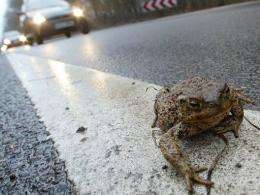Toads' earthquake exodus

Common toads (Bufo bufo) can detect impending seismic activity and alter their behaviour from breeding to evacuation mode, suggests a new study in the Zoological Society of London's (ZSL) Journal of Zoology.
Researchers from The Open University reported that 96 per cent of male toads in a population abandoned their breeding site five days before the earthquake that struck L'Aquila in Italy in 2009. The breeding site was located 74 km from the earthquake's epicentre.
The number of paired toads at the breeding site also dropped to zero three days before the earthquake. No fresh spawn was found at the site from the date that the earthquake struck to the date of the last significant aftershock (magnitude >4.5).
Breeding sites are male-dominated and the toads would normally remain in situ from the point that breeding activity begins, to the completion of spawning.
This shift in the toads' behaviour coincided with disruptions in the ionosphere, the uppermost electromagnetic layer of the earth's atmosphere, which were detected using very low frequency (VLF) radio sounding.
The release of radon gas, or gravity waves prior to an earthquake have both been attributed to changes in atmospheric electric fields and currents. In this case the cause of the ionosphere disruptions was not determined.
Other environmental changes that affect toad behaviour, including lunar phases and changing weather conditions were accounted for. The number of toads breeding at the study site was known to increase during a full moon. However, following the earthquake the number of toads present during a full moon was 34, in comparison to between 67 and 175 individuals in previous years.
"Our study is one of the first to document animal behaviour before, during and after an earthquake. Our findings suggest that toads are able to detect pre-seismic cues such as the release of gases and charged particles, and use these as a form of earthquake early warning system," says lead author Dr Rachel Grant.
More information: www.wiley.com/bw/journal.asp?ref=0952-8369
Provided by Zoological Society of London














